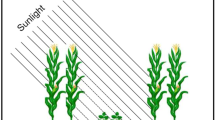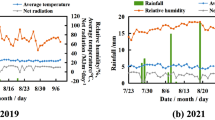Abstract
Intraspecific competition for light affects nutrient uptake of maize, especially during the seed filling phase (from the blistering-stage to physiological-maturity). Partial leaf removal only affects the top leaves and improves the light-environment, which could then enhance nutrient uptake during the seed filling phase. However, there is a shortage of quantitative information on the yield effects of such a management measure. A 3-year field trial was conducted to evaluate the impact of different leaf removal treatments (no removal of leaves (D0: control), removal of two leaves (D2), removal of four leaves (D4), and removal of six leaves (D6) from maize-canopy) on total dry matter accumulation, and nitrogen, phosphorus, and potassium uptake at the blistering-stage and physiological-maturity, plus seed number per plant, seed weight, and seed yield at physiological maturity. Compared to D0, at physiological-maturity, D2 significantly increased total dry matter accumulation (by 9%), and uptake of nitrogen (by 5%), phosphorus (by 10%), and potassium (by 4%); while excessive leaf removal treatments considerably reduced dry matter accumulation and nutrient uptake. Importantly, during the seed filling phase of maize, treatment D2 significantly enhanced the uptake of nitrogen, phosphorus, and potassium by 76%, 40%, and 65%, respectively, compared to control. Treatment D2 increased seed number per plant (by 6.4%, from 448 under D0 to 477 in D2) and seed weight (by 5.7%). Relative to control, maize in D2 had 12%, 14%, and 11%, higher seed-yields in 2017, 2018, and 2019, respectively, and it also improved the economic profit when taking into account labor costs.
Graphic abstract
Graphical representation of changes in light transmittance, photosynthesis, nutrient uptake, carbohydrate, and dry matter accumulation in maize plants as affected by different leaf removal treatments. Treatment codes represent no defoliation (D0: control), removal of two leaves (D2), removal of four leaves (D4), and removal of six leaves (D6) from the top of maize canopy. Yellow and green arrows show the light environment and leaf area of maize plants. The black arrows represent the regulating directions of leaf removal treatments on maize growth and development in this paper. The graphical abstract clearly demonstrates the significant improvement of optimum leaf removal treatment (D2) as compared to control (D0). The red and blue arrows show the relevant increase and decrease of the mentioned components between the optimal leaf removal and control.




Similar content being viewed by others
References
Arduini I, Masoni A, Ercoli L, Mariotti M (2006) Grain yield, and dry matter and nitrogen accumulation and remobilization in durum wheat as affected by variety and seeding rate. Eur J Agron 25:309–318
Batten GD (1992) A review of phosphorus efficiency in wheat. Plant Soil 146:163–168
Borrás L, Slafer GA, Otegui ME (2004) Seed dry weight response to source–sink manipulations in wheat, maize and soybean: a quantitative reappraisal. Field Crops Res 86:131–146
Chen P et al (2017) Effects of reduced nitrogen inputs on crop yield and nitrogen use efficiency in a long-term maize-soybean relay strip intercropping system. PLoS ONE 12:e0184503
Connor DJ, Loomis RS, Cassman KG (2011) Crop ecology: productivity and management in agricultural systems. Cambridge University Press, Cambridge
Cox MC, Qualset CO, Rains DW (1985) Genetic variation for nitrogen assimilation and translocation in wheat. I. Dry matter and nitrogen accumulation. Crop Sci 25:430–435
Damptey H (1982) The effect of water deficit, hormones and mineral nutrition on the growth of axillary inflorescence in Zea Mays L. Ghana J Sci
Dordas CA, Sioulas C (2008) Safflower yield, chlorophyll content, photosynthesis, and water use efficiency response to nitrogen fertilization under rainfed conditions. Ind Crops Prod 27:75–85
Elliott D, Reuter D, Reddy G, Abbott R (1997) Phosphorus nutrition of spring wheat (Triticum aestivum L.). 1. Effects of phosphorus supply on plant symptoms, yield, components of yield, and plant phosphorus uptake. Aust J Agric Res 48:855–868
Feng LY et al (2019) Narrow-wide row planting pattern improves the light environment and seed yields of intercrop species in relay intercropping system. PLoS ONE 14:e0212885
Grogan CO (1956) Detasseling responses in corn 1. Agronomy J 48:247–249
Guitman MR, Arnozis PA, Barneix AJ (1991) Effect of source-sink relations and nitrogen nutrition on senescence and N remobilization in the flag leaf of wheat. Physiol Plant 82:278–284
Heitholt JJ, Croy L, Maness N, Nguyen H (1990) Nitrogen partitioning in genotypes of winter wheat differing in grain N concentration. Field crops Res 23:133–144
Henry LT, Raper CD Jr (1991) Soluble carbohydrate allocation to roots, photosynthetic rate of leaves, and nitrate assimilation as affected by nitrogen stress and irradiance. Bot Gaz 152:23–33
Iqbal A, Hidayat Z (2016) Potassium management for improving growth and grain yield of maize (Zea mays L.) under moisture stress condition. Sci Rep 6:34627
Jun X, Ling G, Shi Z-G, Zhao Y-S, Zhang W-F (2017) Effect of leaf removal on photosynthetically active radiation distribution in maize canopy and stalk strength. J Integr Agric 16:85–96
Karam D, PereiraFilho IA, Magalhães PC, Paes MCD, Silva JAA, Gama JDCM (2010) Resposta de plantas de milho à simulação de danos mecânicos. Revista Brasileira de Milho e Sorgo 9:201–211
Kefu Z (1981) Effect of the leaves of different positions in maize on the corn yield and the photosynthetic properties of those leaves after the growing out of the female flowers. Acta Agrono Sin 4:005
Khanna-Chopra R, Maheswari M (1998) Effect of altering source availability on expression of sink capacity in a maize hybrid and its parents. Eur J Agron 9:101–107
Kitonyo OM, Sadras VO, Zhou Y, Denton MD (2018) Nitrogen supply and sink demand modulate the patterns of leaf senescence in maize. Field crops Res 225:92–103
Li T, Liu L-N, Jiang C-D, Liu Y-J, Shi L (2014) Effects of mutual shading on the regulation of photosynthesis in field-grown sorghum. J Photochem Photobiol B 137:31–38
Liu T, Gu L, Dong S, Zhang J, Liu P, Zhao B (2015) Optimum leaf removal increases canopy apparent photosynthesis, 13 C-photosynthate distribution and grain yield of maize crops grown at high density. Field Crops Res 170:32–39
Liu T, Huang R, Cai T, Han Q, Dong S (2017) Optimum leaf removal increases nitrogen accumulation in kernels of maize grown at high density. Sci Rep 7:39601
Medford J, Klee H (1989) Manipulation of endogenous auxin and cytokinin levels in transgenic plants. In: UCLA symposia on molecular and cellular biology (USA)
Miralles DJ, Slafer GA (2007) Sink limitations to yield in wheat: How could it be reduced? J Agric Sci 145(2):139–149
Muchow R, Davis R (1988) Effect of nitrogen supply on the comparative productivity of maize and sorghum in a semi-arid tropical environment II. Radiation interception and biomass accumulation. Field Crops Res 18:17–30
Palmer S, Berridge DM, McDonald A, Davies W (1996) Control of leaf expansion in sunflower (Helianthus annuus L.) by nitrogen nutrition. J Exp Bot 47:359–368
Papakosta DK (1994) Phosphorus accumulation and translocation in wheat as affected by cultivar and nitrogen fertilization. J Agron Crop Sci 173:260–270
Papakosta DK, Gagianas A (1991) Nitrogen and dry matter accumulation, remobilization, and losses for Mediterranean wheat during grain filling. Agron J 83:864–870
Peel MC, Finlayson BL, McMahon TA (2007) Updated world map of the Köppen–Geiger climate classification. Hydrol Earth Syst Sci 11:1633–1644
Prystupa P, Savin R, Slafer GA (2004) Grain number and its relationship with dry matter, N and P in the spikes at heading in response to N × P fertilization in barley. Field Crops Res 90:245–254
Raza M et al (2018a) Effect of sulphur application on photosynthesis and biomass accumulation of sesame varieties under rainfed conditions. Agronomy 8:149
Raza MA et al (2018b) Sulphur application increases seed yield and oil content in sesame seeds under rainfed conditions. Field Crops Res 218:51–58. https://doi.org/10.1016/j.fcr.2017.12.024
Raza MA et al (2019a) Optimum leaf excision increases the biomass accumulation and seed yield of maize plants under different planting patterns. Ann Appl Biol 175:1–15. https://doi.org/10.1111/aab.12514
Raza MA et al (2019b) Maize leaf-removal: a new agronomic approach to increase dry matter, flower number and seed-yield of soybean in maize soybean relay intercropping system. Sci Rep 9:1–13
Raza MA et al (2019c) Optimum leaf defoliation: a new agronomic approach for increasing nutrient uptake and land equivalent ratio of maize soybean relay intercropping system. Field Crops Res 244:107647
Raza MA et al (2019d) Effect of planting patterns on yield, nutrient accumulation and distribution in maize and soybean under relay intercropping systems. Sci Rep 9:4947
Sinclair TR, Rufty TW, Lewis RS (2019) Increasing photosynthesis: unlikely solution for world food problem. Trends Plant Sci 24:1032–1039
Spiertz J, Ellen J (1978) Effects of nitrogen on crop development and grain growth of winter wheat in relation to assimilation and utilization of assimilates and nutrients. Neth J Agric Sci 26:210–231
Tollenaar M, Daynard T (1978) Effect of defoliation on kernel development in maize. Can J Plant Sci 58:207–212
Valladares F, Niinemets Ü (2008) Shade tolerance, a key plant feature of complex nature and consequences. Annu Rev Ecol Evol Syst 39:237–257
Vouillot M, Devienne-Barret F (1999) Accumulation and remobilization of nitrogen in a vegetative winter wheat crop during or following nitrogen deficiency. Ann Bot 83:569–575
Wu Y, Gong W, Yang W (2017) Shade inhibits leaf size by controlling cell proliferation and enlargement in soybean. Sci Rep 7:9259. https://doi.org/10.1038/s41598-017-10026-5
Yang F et al (2017) Effect of aboveground and belowground interactions on the intercrop yields in maize–soybean relay intercropping systems. Field Crops Res 203:16–23. https://doi.org/10.1016/j.fcr.2016.12.007
Zhou T, Wang L, Gao Y, Du YL, Zhao L, Guo LW (2019) Interactions between light intensity and phosphorus nutrition affect the P uptake capacity of maize and soybean seedling in a low light intensity area. Front Plant Sci 10:183
Acknowledgements
The research was supported by the National Key Research and Development Program of China (2016YFD0300209), the National Nature Science Foundation (31571615), and Program on Industrial Technology System of National Soybean (CARS-04-PS19). Authors thanks to Stewart Smock Higgins, Department of Biological Systems Engineering, Washington State University Pullman USA, for helping in the English editing and improvement of the article. Muhammad Ali Raza’s thanks to MUHAMMAD (Salallahu Alayhi Wasalam) for enlightening his life.
Author information
Authors and Affiliations
Corresponding author
Ethics declarations
Conflict of interest
The authors declare that they have no conflict of interest.
Additional information
Publisher's Note
Springer Nature remains neutral with regard to jurisdictional claims in published maps and institutional affiliations.
Electronic supplementary material
Below is the link to the electronic supplementary material.
Rights and permissions
About this article
Cite this article
Raza, M.A., van der Werf, W., Ahmed, M. et al. Removing top leaves increases yield and nutrient uptake in maize plants. Nutr Cycl Agroecosyst 118, 57–73 (2020). https://doi.org/10.1007/s10705-020-10082-w
Received:
Accepted:
Published:
Issue Date:
DOI: https://doi.org/10.1007/s10705-020-10082-w




